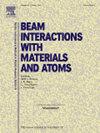用电阻硅探测器绘制薄箔的厚度和均匀性
IF 1.4
3区 物理与天体物理
Q3 INSTRUMENTS & INSTRUMENTATION
Nuclear Instruments & Methods in Physics Research Section B-beam Interactions With Materials and Atoms
Pub Date : 2025-07-07
DOI:10.1016/j.nimb.2025.165788
引用次数: 0
摘要
能量损失是测量目标厚度的常用工具。然而,这些测量通常是在没有位置信息的情况下进行的,这要么丧失了对材料均匀性和局部厚度的了解,要么需要对每个目标进行大量测量才能部分恢复这些信息。考虑到这一点,本文描述了一种测量位置相关厚度的方法;通过使用双轴双侧向(DADL)硅探测器的位置灵敏度,单次测量可以测量整个材料表面的厚度到亚毫米精度。给出了几个使用具有不同特征的目标的示例,这些示例共同演示了该技术的精确性、准确性和通用性。本文章由计算机程序翻译,如有差异,请以英文原文为准。
Thickness and uniformity mapping of thin foils using resistive silicon detectors
Alpha energy loss is a common tool used for measuring target thicknesses. However, these measurements are often made without position information, which either forfeits knowledge of material uniformity and local thickness or requires a prohibitive number of measurements per target to partially recover this information. In consideration of this, a method for measuring position-dependent thicknesses is described in this work; by using the position-sensitivity of the dual-axis duo-lateral (DADL) silicon detector, thicknesses across the entire face of the material can be measured to sub-mm precision with a single measurement. Several examples are presented using a number of targets with varying characteristics, which altogether demonstrate the precision, accuracy, and versatility of this technique.
求助全文
通过发布文献求助,成功后即可免费获取论文全文。
去求助
来源期刊
CiteScore
2.80
自引率
7.70%
发文量
231
审稿时长
1.9 months
期刊介绍:
Section B of Nuclear Instruments and Methods in Physics Research covers all aspects of the interaction of energetic beams with atoms, molecules and aggregate forms of matter. This includes ion beam analysis and ion beam modification of materials as well as basic data of importance for these studies. Topics of general interest include: atomic collisions in solids, particle channelling, all aspects of collision cascades, the modification of materials by energetic beams, ion implantation, irradiation - induced changes in materials, the physics and chemistry of beam interactions and the analysis of materials by all forms of energetic radiation. Modification by ion, laser and electron beams for the study of electronic materials, metals, ceramics, insulators, polymers and other important and new materials systems are included. Related studies, such as the application of ion beam analysis to biological, archaeological and geological samples as well as applications to solve problems in planetary science are also welcome. Energetic beams of interest include atomic and molecular ions, neutrons, positrons and muons, plasmas directed at surfaces, electron and photon beams, including laser treated surfaces and studies of solids by photon radiation from rotating anodes, synchrotrons, etc. In addition, the interaction between various forms of radiation and radiation-induced deposition processes are relevant.

 求助内容:
求助内容: 应助结果提醒方式:
应助结果提醒方式:


